Il tuo messaggio è stato inviato.
Elaboreremo la vostra richiesta e vi ricontatteremo al più presto.
Il modulo è stato inviato con successo.
Ulteriori informazioni sono contenute nella vostra casella di posta elettronica.
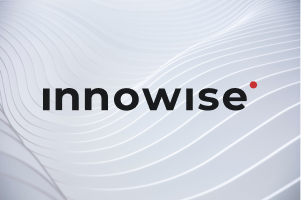
Selezionare la lingua
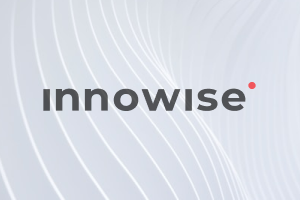
Sia che stiate cercando di ottimizzare i flussi di lavoro in un ospedale o di portare sul mercato un prodotto medico innovativo, avrete sicuramente bisogno di un qualche tipo di applicazione. È probabile che lo sviluppo di software sanitario sia entrato nel vostro radar. Non siete i soli: molte aziende vedono il valore del software, per cui si prevede che il mercato globale dell'IT sanitario crescerà da $663B nel 2023 a un tasso annuo sbalorditivo di 15,8% fino al 2030.
comportare un risparmio netto fino a $360 miliardi. comportare un risparmio netto fino a $360 miliardi.
Come per qualsiasi altro progetto ad alto rischio, l'avvio dello sviluppo di un software sanitario può essere travolgente. Questa guida vi aiuterà a capire cosa comporta la creazione di un software medico efficace, conforme e pronto per il futuro. In questo articolo, vi guiderò attraverso gli elementi essenziali: dalla pianificazione del processo di sviluppo alla gestione delle normative e all'evitare costose insidie.
Lo sviluppo di software per il settore sanitario comprende la creazione di un ampio spettro di soluzioni informatiche, dalle applicazioni per i pazienti e i sistemi EHR alle applicazioni per i pazienti software per dispositivi medici. Ciò che lo distingue da altri settori come la finanza o l'e-commerce è il peso della responsabilità. Qualsiasi errore può non solo causare tempi di inattività e multe, ma anche compromettere la salute delle persone e non tutti i fornitori di software sono pronti ad assumersi questo livello di responsabilità e a mantenere le promesse.
In base alla mia esperienza, questi sono gli aspetti fondamentali a cui prestare attenzione durante lo sviluppo di software per uso medico.

Il software sanitario è molto vario, dalle applicazioni per il monitoraggio delle attività alle complesse soluzioni diagnostiche. Ecco alcuni dei tipi più comuni di software sanitario che possiamo aiutarvi a costruire e implementare.
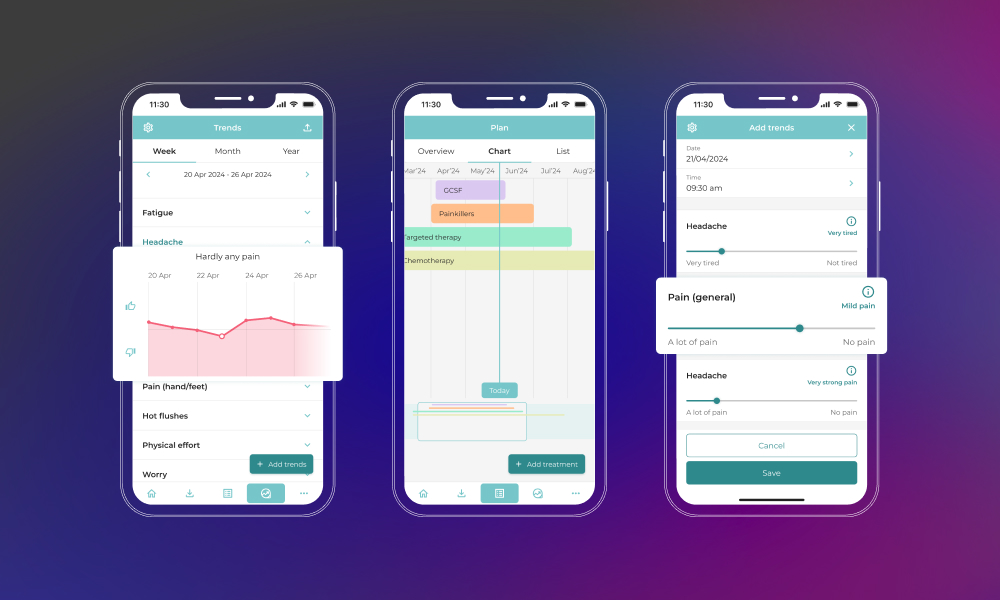
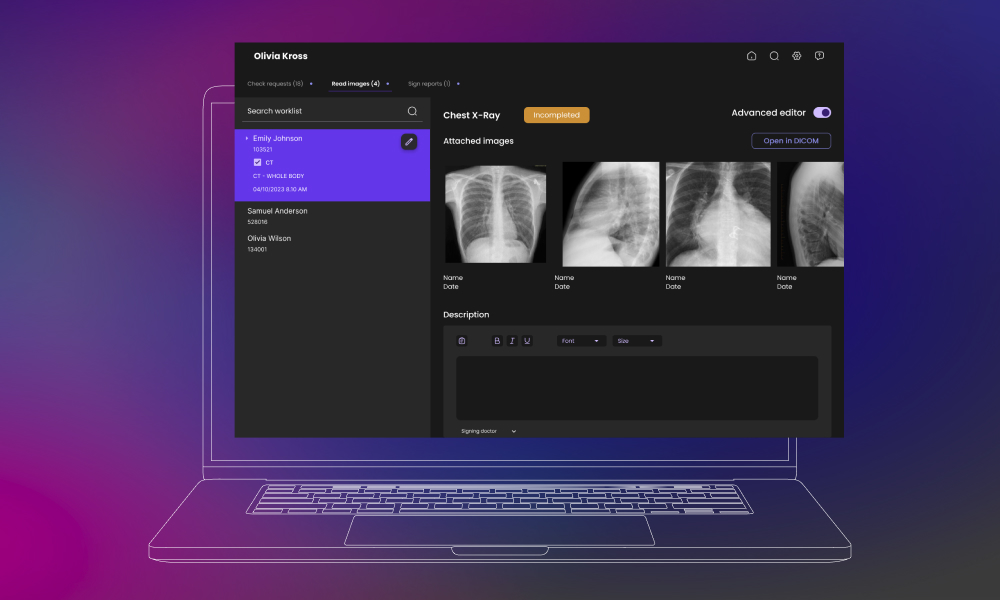
Quando si parla di sviluppo di software per la sanità, la maggior parte delle organizzazioni si trova di fronte a un bivio: acquistare una soluzione già pronta e personalizzarla o costruirne una su misura. Entrambe le strade hanno i loro meriti e la scelta giusta dipende sempre dalle esigenze aziendali.
Le soluzioni off-the-shelf sono sistemi già pronti che possono essere implementati rapidamente. L'attrattiva è ovvia: implementazione più rapida, costi iniziali più bassi e funzionalità già collaudate e utilizzate dalle organizzazioni sanitarie.
Le piattaforme pronte all'uso tendono a offrire una personalizzazione limitata, il che rende difficile adattare i flussi di lavoro alle vostre esatte esigenze o integrarli nell'ambiente IT esistente. A lungo termine, le spese operative per le soluzioni standard sono molto più elevate rispetto a quelle per il software personalizzato: i costi di licenza tendono ad accumularsi.
Inoltre, è inevitabile che ci sia un vendor lock. È difficile migrare le configurazioni e i dati da un sistema all'altro, nel caso in cui si voglia passare a un'altra piattaforma grazie a funzionalità migliori o a prezzi più bassi. La sicurezza può essere un altro problema, soprattutto quando il fornitore non offre sufficienti funzioni di sicurezza o non segue i protocolli di conformità specifici della vostra regione.
Questo percorso è ideale per le startup digitali e i fornitori di servizi sanitari con flussi di lavoro unici. Ottenete un sistema su misura per le vostre esatte esigenze, progettato tenendo conto dei vostri utenti e costruito per scalare insieme alla vostra attività. Le misure di sicurezza sono implementate da zero e il software è allineato con HIPAA, GDPR, MDR o qualsiasi altro quadro normativo applicabile al vostro caso.
Naturalmente, la realizzazione di un software personalizzato richiede più tempo e di solito un investimento più elevato. Tuttavia, in ambienti sanitari ad alto rischio, la possibilità di adattare, estendere e possedere completamente il software vale spesso la pena.
Poiché le soluzioni mediche variano molto in termini di funzionalità e casi d'uso, anche i vantaggi che apportano possono essere molto diversi. Ad esempio, un progetto di sviluppo di un software di gestione sanitaria probabilmente automatizzerà i flussi di lavoro di routine all'interno di uno studio, la costruzione di un CDSS porterà a diagnosi più accurate e lo sviluppo di un software ospedaliero fornirà un quadro completo dei processi assistenziali e operativi.
Detto questo, ecco i vantaggi più comuni riscontrati dai clienti di Innowise.
Molte soluzioni sanitarie influenzano direttamente o indirettamente l'esperienza dei pazienti, aiutandoli a rimanere informati e a rendere più fluida l'interazione complessiva con gli operatori sanitari. Dai promemoria degli appuntamenti alla facilità di accesso ai dettagli delle cure, tutto contribuisce a rendere più soddisfacente l'esperienza sanitaria.
Il software riduce la necessità di inserimento manuale e standardizza la gestione dei dati, riducendo le possibilità di errore. Con informazioni più accurate a disposizione, i team di assistenza possono prendere decisioni migliori e ottenere risultati migliori in termini di salute.
Un software ben progettato riduce i passaggi inutili, automatizza le attività di routine e semplifica i flussi di lavoro. In questo modo si lascia più tempo per le attività più importanti, si velocizza l'erogazione dei servizi e si migliora l'allocazione del personale e delle risorse.
Il software aiuta le organizzazioni sanitarie a spendere in modo più intelligente, identificando le inefficienze, riducendo al minimo le pratiche burocratiche e migliorando l'utilizzo delle apparecchiature. Nel tempo, questo porta a una riduzione delle spese operative e a una fornitura di cure più sostenibile.
I protocolli di sicurezza implementati aiutano a salvaguardare i dati medici sensibili. Grazie ai controlli di accesso, all'archiviazione criptata dei dati e al monitoraggio regolare, il software sanitario supporta la privacy dei dati personali e resiste a potenziali violazioni.
Se costruito correttamente, il software segue alla lettera le normative specifiche del settore. Non dovete preoccuparvi di imminenti controlli di conformità, di spese per la non conformità o di perdite di dati dei pazienti, perché sapete che il software è allineato a tutti gli standard legali applicabili.
La spina dorsale di ogni progetto di sviluppo di software sanitario di successo, la Ciclo di vita dello sviluppo del software (SDLC) mantenere il progetto senza intoppi e raggiungere gli obiettivi aziendali e i KPI.
Esistono diversi modi per affrontare l'SDLC, a seconda dell'organizzazione, del tipo di software e della classe di rischio. Nella maggior parte dei casi, noi di Innowise seguiamo metodologie Agile, come Scrum o Kanban. Il nostro team si affida a un approccio collaudato, perfezionato attraverso decine di progetti di successo e adattato al software medico ad alto rischio. Ecco come si presenta di solito il nostro processo.
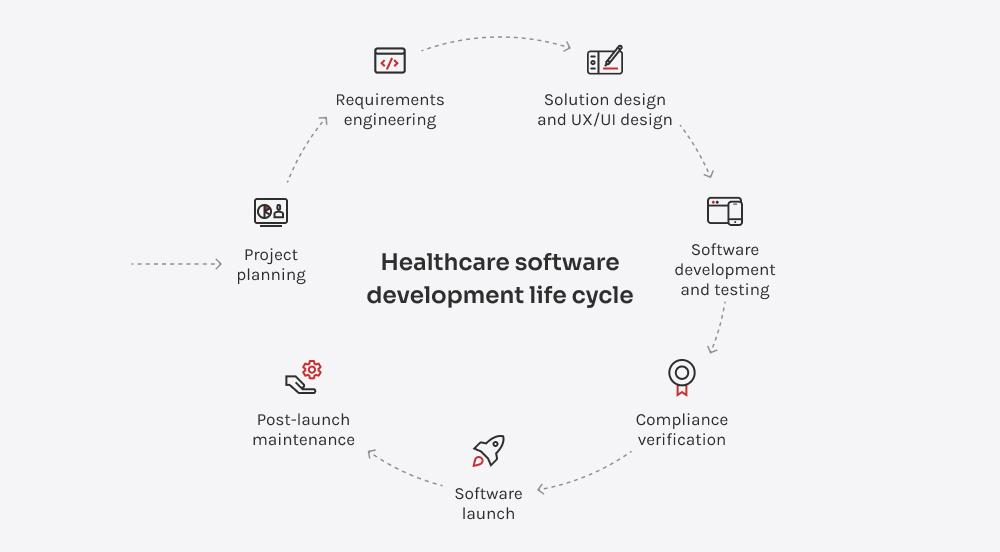
In questa fase, lavoriamo con voi per definire la visione del software, individuare i rischi e definire l'ambito del progetto. Inoltre, il nostro team verifica le normative applicabili. Se il progetto rientra nella categoria dei software per dispositivi medici, delineiamo anche la classe normativa (secondo FDA e MDR), il percorso normativo applicabile e la documentazione di progetto necessaria.
L'obiettivo principale di questa fase è definire un piano di alto livello che garantisca l'allineamento del progetto con gli obiettivi aziendali, le tempistiche di consegna e i requisiti di conformità.
Il team di Innowise raccoglie e analizza tutti i requisiti funzionali e non funzionali, pensando ai ruoli degli utenti, ai flussi di lavoro clinici, alle esigenze di integrazione, ai limiti tecnici e agli scenari di utilizzo. Creiamo inoltre un piano di sviluppo, una roadmap di V&V e allineiamo tutto alle normative vigenti. Per i progetti di software per dispositivi medici, seguiamo rigorosamente gli standard ISO 13485 e IEC 62304.
Qui creiamo il progetto tecnico sulla base dei requisiti raccolti. Ciò include la progettazione dell'architettura del software, la delineazione delle funzionalità, la pianificazione delle integrazioni software e hardware, la selezione degli standard di interoperabilità più adatti (come FHIR o HL7) e l'elaborazione di strategie di protezione dei dati.
Poi i nostri designer UX/UI tracciano il percorso dell'utente per i pazienti, i medici o il personale amministrativo e creano interfacce intuitive. Nel settore sanitario, il design non si limita all'aspetto estetico, ma riguarda l'accessibilità, la chiarezza e la riduzione al minimo degli errori dell'utente. Seguiamo le linee guida per l'accessibilità WCAG e possiamo sviluppare anche interfacce di livello AAA.
Pertanto, nei nostri progetti sanitari, lo sviluppo procede per iterazioni, con backend e frontend costruiti e testati in parallelo. Il nostro team presta particolare attenzione alla QA perché, nel settore sanitario, anche piccoli errori possono avere gravi conseguenze. Eseguiamo test unitari, di integrazione e di sistema in anticipo e spesso per individuare bug, problemi di prestazioni o difetti di usabilità.
In questa fase, implementiamo anche i controlli di rischio, realizziamo integrazioni di software o dispositivi intelligenti e manteniamo una documentazione completa per supportare i futuri audit e le richieste di normative SaMD/SiMD.
In questo caso, ogni aspetto viene esaminato alla luce di normative rilevanti come HIPAA, GDPR, MDR o FDA e di standard come ISO 13485 o IEC 62304. Per i progetti di software per dispositivi medici, ci assicuriamo anche che il prodotto funzioni come previsto in condizioni reali o simulate.
Sia che il software supporti la diagnosi o gestisca dati sanitari protetti, Innowise verifica che sia costruito per superare audit, certificazioni e valutazioni cliniche. Per prepararci alla revisione normativa, raccogliamo la documentazione completa del progetto (ad esempio, il fascicolo tecnico).
Una volta completati lo sviluppo e i controlli di conformità, si passa alla distribuzione. Questo include la configurazione di un ambiente live, il rilascio della soluzione e la preparazione di guide di formazione per gli utenti.
Per i progetti SaMD/SiMD, Innowise si assicura che il software sia approvato dalle autorità competenti prima del lancio. In questa fase, inoltre, viene istituito un sistema di sorveglianza post-vendita, in modo da monitorare tempestivamente le prestazioni, la sicurezza e gli esiti clinici.
In base alla mia esperienza, lo sviluppo di software per il settore sanitario non è un lavoro unico e definitivo. Per questo motivo, dopo il rilascio, il team di Innowise monitora le prestazioni, rilascia aggiornamenti e modifica il software medico in base al feedback degli utenti. Inoltre, aggiorniamo il software in linea con l'evoluzione delle esigenze, dei processi clinici e delle normative, per mantenerlo sicuro ed efficiente nel tempo.
La creazione di software per il settore sanitario non è priva di sfide, ma sono tutt'altro che insormontabili. Quando si collabora con fornitori esperti come Innowise, molti di questi rischi vengono mitigati fin dalle prime fasi del processo. Grazie a un'attenta pianificazione, alla competenza tecnica e alla conoscenza del settore, i miei colleghi e io sappiamo come affrontare questi problemi in modo efficace.
I progetti di sviluppo del software sanitario devono soddisfare numerose normative: HIPAA, GDPR, HITECH e altre ancora. Ognuna di esse aggiunge livelli di complessità, soprattutto per soluzioni come SaMD o SiMD.
Come lo risolviamo: La chiave è considerare i requisiti e le limitazioni di conformità fin dal primo giorno e pianificare il progetto in base ad essi. Ad esempio, firmiamo l'Accordo di Business Associate con i clienti che devono rispettare la normativa HIPAA prima dell'inizio dello sviluppo. Inoltre, le PMI di Innowise raccolgono la documentazione necessaria in ogni fase del progetto. Questo ci aiuta a garantire che ogni aspetto dello sviluppo del software clinico sia ben documentato e pronto per gli audit e le presentazioni.
Le tecnologie sanitarie e i protocolli di scambio dati sono in continua evoluzione, il che rende la loro implementazione più complessa e frustrante.
Come lo risolviamo: Lavorando quotidianamente con i clienti del settore sanitario, il team di Innowise è immerso nelle esigenze e nei cambiamenti del settore. È per questo che teniamo traccia di tutti i cambiamenti tecnologici e normativi più importanti e molti dei nostri clienti concordano sul fatto che parliamo la stessa lingua. D'altra parte, il team di Innowise dispone di un'ampia gamma di talenti, compresi quelli esperti in tecnologie avanzate come AI, ML, big data e blockchain, e possiamo sempre accedere a queste competenze durante i progetti di sviluppo del software sanitario.
L'integrazione di un nuovo software negli ecosistemi sanitari esistenti, che si tratti di un EHR, di un PACS, di un CRM o di un dispositivo connesso, spesso comporta problemi di compatibilità. Questi possono andare da formati di dati incoerenti ad API obsolete.
Come lo risolviamo: Con anni di esperienza pratica con standard sanitari come HL7, FHIR e DICOM alle spalle, iniziamo con una valutazione approfondita dell'infrastruttura esistente per identificare tempestivamente i potenziali problemi di integrazione. Se necessario, i nostri ingegneri sviluppano connettori personalizzati e script di trasformazione dei dati. Inoltre, eseguiamo test di compatibilità utilizzando dati simulati e reali per convalidare l'integrazione prima della distribuzione.
Il software sanitario è spesso destinato a un'ampia gamma di ruoli - medici, pazienti, amministratori - ognuno con esigenze diverse.
Come lo risolviamo: La progettazione di una soluzione potente ma non opprimente richiede un'attenta ricerca UX, la definizione delle priorità delle funzionalità e test iterativi con scenari utente reali. Il team di Innowise crea interfacce specifiche per ogni ruolo con funzionalità su misura, assicurando che le caratteristiche critiche siano ben visibili e di facile accesso. La prototipazione e i primi test di usabilità ci consentono di raccogliere il feedback degli utenti reali, che utilizziamo per perfezionare l'interfaccia e ottimizzare i flussi di lavoro.
Non è possibile stabilire un prezzo per lo sviluppo di software in ambito sanitario senza conoscere le specifiche. I costi di una semplice applicazione di promemoria per i farmaci e di un CDSS basato su AI variano molto, quindi il tutto si riduce a ciò che si sta costruendo. Ecco i fattori chiave che determinano i prezzi.
Se si esternalizza lo sviluppo, il costo di sviluppo del software sanitario dipende anche da:
Nel corso degli anni abbiamo realizzato oltre 100 progetti in ambito sanitario, come questa applicazione scanner cutaneo con una precisione diagnostica di 80% o questa applicazione MVP di consulenza medica costruita in soli 3 mesi. Se siete alla ricerca di un partner per lo sviluppo di software sanitario che trasformi la vostra idea in realtà, puntateci una linea.

Condividi:



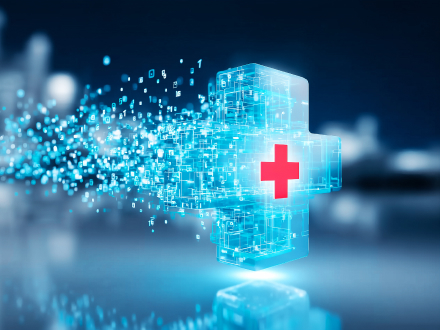




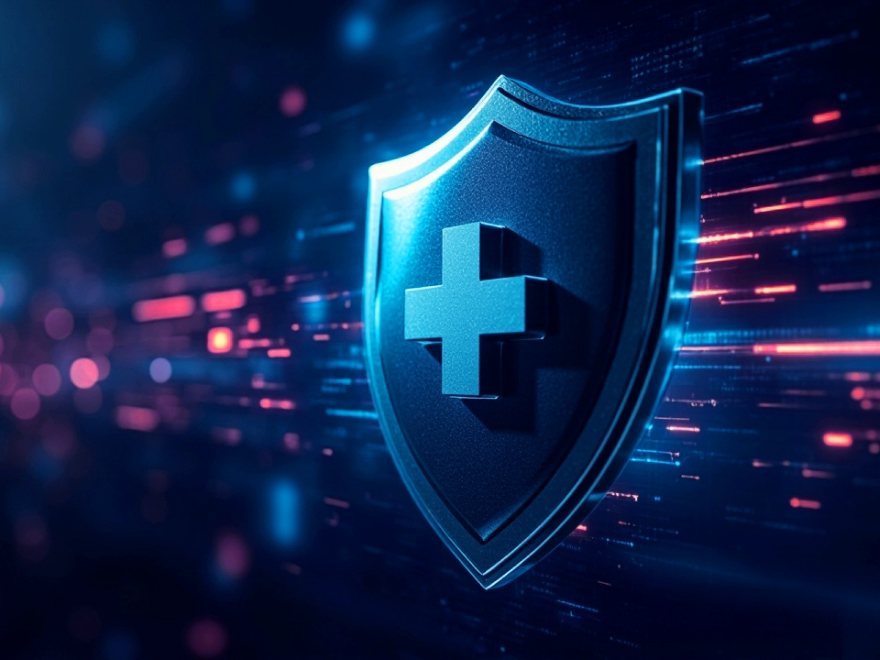
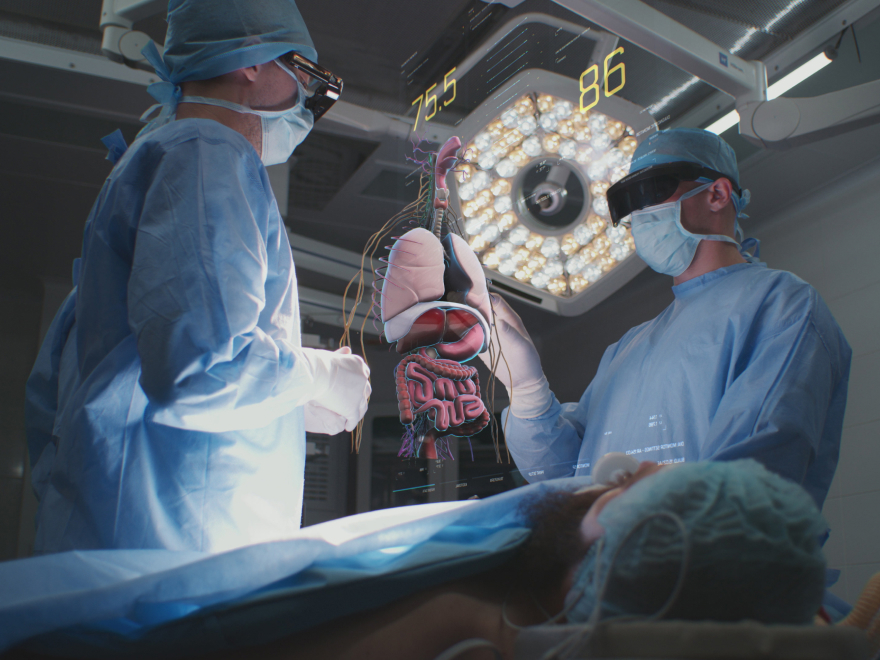
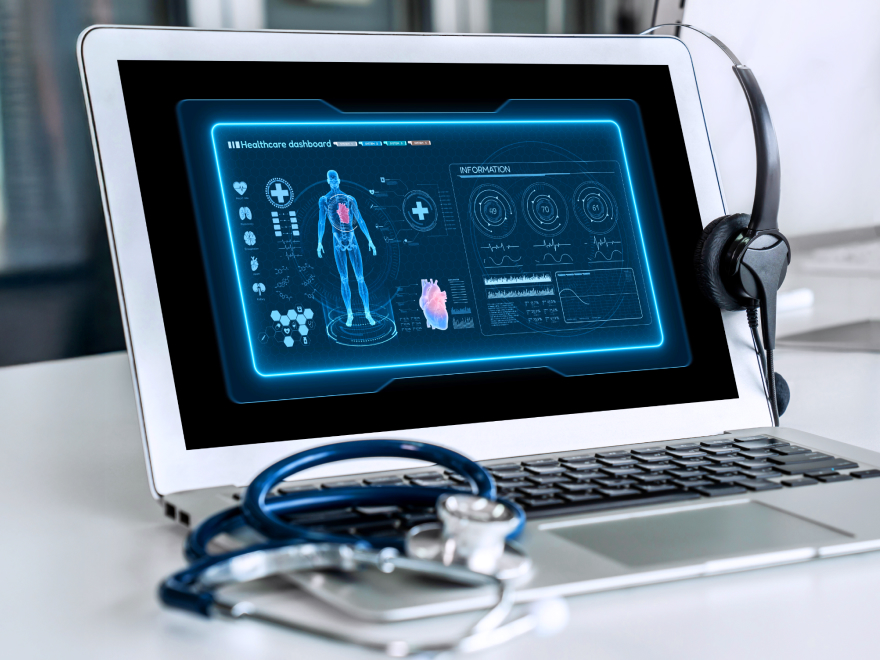


Il tuo messaggio è stato inviato.
Elaboreremo la vostra richiesta e vi ricontatteremo al più presto.

Iscrivendosi si accetta il nostro Informativa sulla privacy, compreso l'uso dei cookie e il trasferimento dei vostri dati personali.